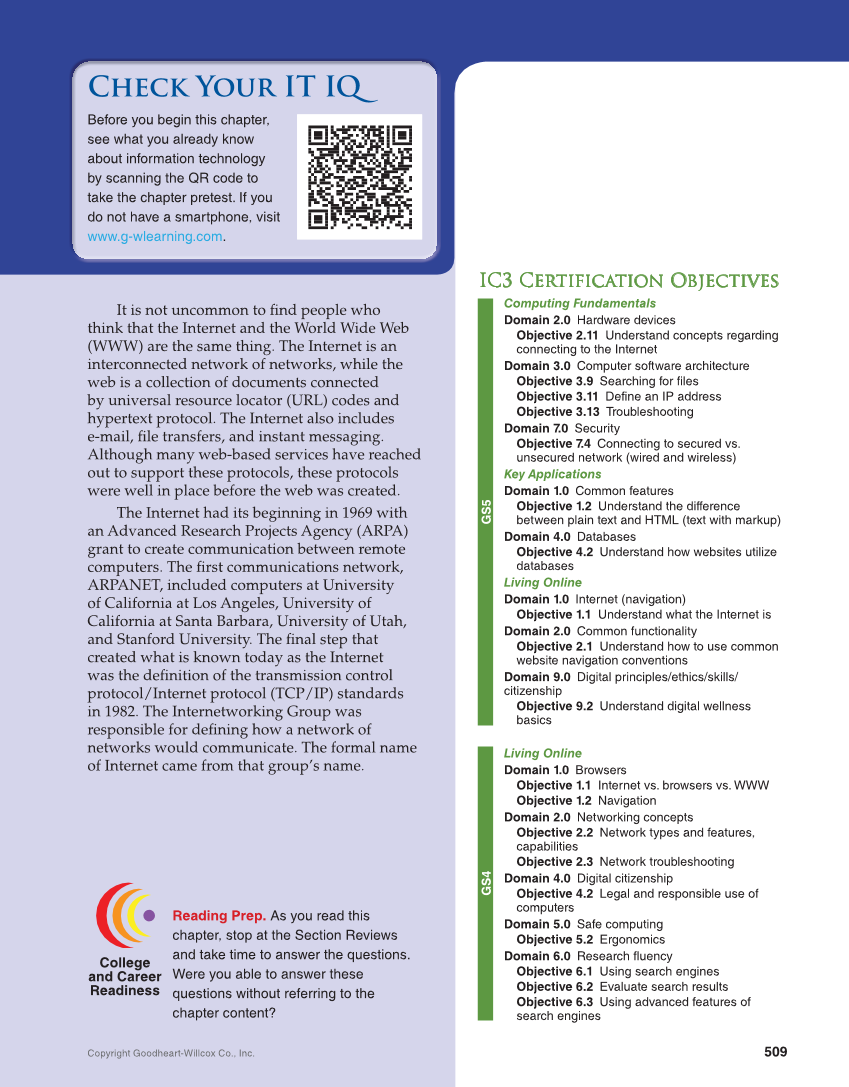Check Your IT IQ 509 Copyright Goodheart-Willcox Co., Inc. It is not uncommon to fi nd people who think that the Internet and the World Wide Web (WWW) are the same thing. The Internet is an interconnected network of networks, while the web is a collection of documents connected by universal resource locator (URL) codes and hypertext protocol. The Internet also includes e-mail, fi le transfers, and instant messaging. Although many web-based services have reached out to support these protocols, these protocols were well in place before the web was created. The Internet had its beginning in 1969 with an Advanced Research Projects Agency (ARPA) grant to create communication between remote computers. The fi rst communications network, ARPANET, included computers at University of California at Los Angeles, University of California at Santa Barbara, University of Utah, and Stanford University. The fi nal step that created what is known today as the Internet was the defi nition of the transmission control protocol/Internet protocol (TCP/IP) standards in 1982. The Internetworking Group was responsible for defi ning how a network of networks would communicate. The formal name of Internet came from that group’s name. College and Career Readiness Reading Prep. As you read this chapter, stop at the Section Reviews and take time to answer the questions. Were you able to answer these questions without referring to the chapter content? Before you begin this chapter, see what you already know about information technology by scanning the QR code to take the chapter pretest. If you do not have a smartphone, visit www.g-wlearning.com. IC3 Certification Objectives IC3 Certification Objectives Computing Fundamentals Domain 2.0 Hardware devices Objective 2.11 Understand concepts regarding connecting to the Internet Domain 3.0 Computer software architecture Objective 3.9 Searching for files Objective 3.11 Define an IP address Objective 3.13 Troubleshooting Domain 7.0 Security Objective 7.4 Connecting to secured vs. unsecured network (wired and wireless) Key Applications Domain 1.0 Common features Objective 1.2 Understand the difference between plain text and HTML (text with markup) Domain 4.0 Databases Objective 4.2 Understand how websites utilize databases Living Online Domain 1.0 Internet (navigation) Objective 1.1 Understand what the Internet is Domain 2.0 Common functionality Objective 2.1 Understand how to use common website navigation conventions Domain 9.0 Digital principles/ethics/skills/ citizenship Objective 9.2 Understand digital wellness basics Living Online Domain 1.0 Browsers Objective 1.1 Internet vs. browsers vs. WWW Objective 1.2 Navigation Domain 2.0 Networking concepts Objective 2.2 Network types and features, capabilities Objective 2.3 Network troubleshooting Domain 4.0 Digital citizenship Objective 4.2 Legal and responsible use of computers Domain 5.0 Safe computing Objective 5.2 Ergonomics Domain 6.0 Research fluency Objective 6.1 Using search engines Objective 6.2 Evaluate search results Objective 6.3 Using advanced features of search engines GS4 GS5
